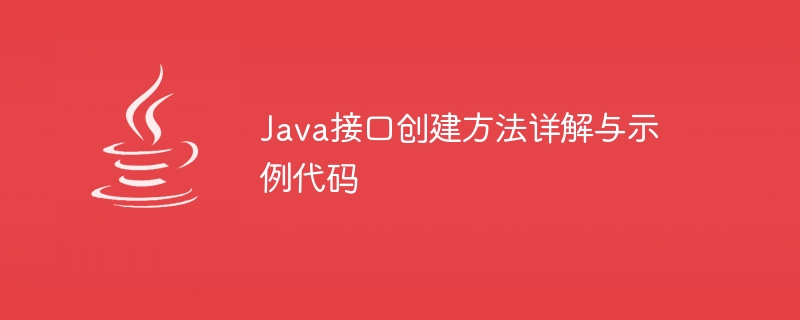Home >Java >javaTutorial >In-depth analysis of method creation and sample code of Java interface
In-depth analysis of method creation and sample code of Java interface
- PHPzOriginal
- 2024-01-04 12:24:041489browse

Detailed explanation of Java interface creation method and sample code
Abstract: This article will introduce the creation method of Java interface in detail and provide actual code examples to help readers better understand Understand and apply interface concepts.
1. What is an interface?
In object-oriented programming, an interface is an abstract data type that defines how a class should be implemented and used. An interface can contain definitions of constants and methods, but not instance fields. It provides a way to decouple classes from each other and make the interactions between classes more flexible and extensible.
2. Creation and Implementation of Interface
In Java, you can create an interface using the interface keyword. The following is a simple interface example:
public interface Animal {
String getSound();
void eat();
}In the above example, we declare an interface named Animal, which defines two abstract methods getSound() and eat(). The methods in the interface have no specific implementation, only the declaration of the method, and the specific implementation is provided by the class that implements the interface.
Interfaces are implemented by classes through the implements keyword. Here is an example that implements the Animal interface:
public class Dog implements Animal {
@Override
public String getSound() {
return "汪汪汪";
}
@Override
public void eat() {
System.out.println("狗在吃东西");
}
}In the above example, the Dog class is implemented# by using the implements keyword ##Animal interface, and provides specific implementations of the getSound() and eat() methods.
public interface Swim {
void swim();
}
public class Duck implements Animal, Swim {
@Override
public String getSound() {
return "嘎嘎嘎";
}
@Override
public void eat() {
System.out.println("鸭子在吃东西");
}
@Override
public void swim() {
System.out.println("鸭子在游泳");
}
} In the above example, the Duck class implements both Animal and Swim interface and provides concrete implementations of all methods. In this way, the Duck class can be used as either Animal or Swim.
- Realize multiple inheritance: A class can implement multiple interfaces at the same time, providing more flexibility inheritance method.
- Decoupling: Interfaces decouple interactions between classes from implementation details, making classes more independent and extensible.
- Specification: The interface provides specifications for the class, making the design of the class more readable and maintainable.
- Plug-in development: By defining interfaces, plug-ins can implement standard interface specifications, so that plug-ins can easily interact with the main program.
- Normative constraints: Interfaces can constrain the behavior and functions of classes and improve the robustness and readability of the code.
- Callback function: Implement the callback function through the interface, making the code more flexible and extensible.
https://docs.oracle.com/javase/tutorial/java/IandI/createinterface.html
The above is the detailed content of In-depth analysis of method creation and sample code of Java interface. For more information, please follow other related articles on the PHP Chinese website!

